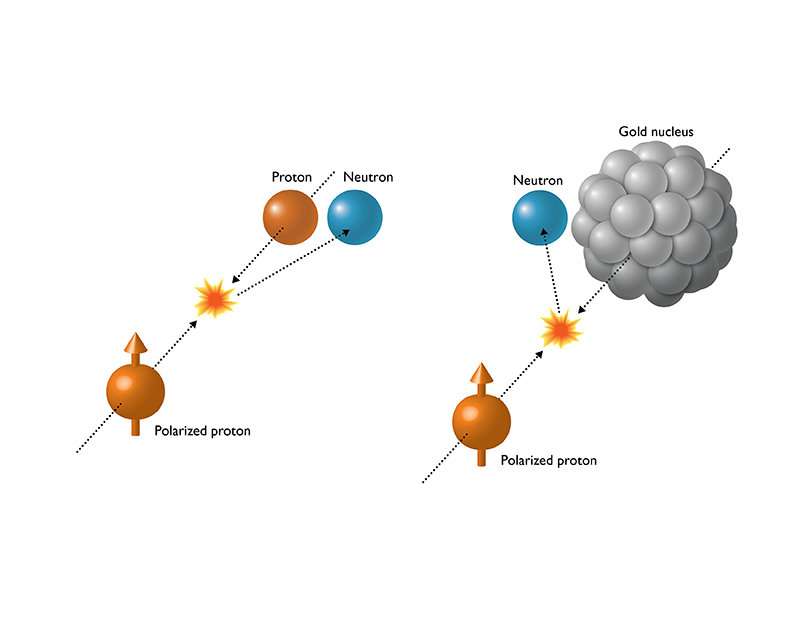Scientists studying nuclear spin make a surprising discovery

In proton-proton smashups, more neutrons scatter to the right than the left relative to the proton spin direction. That was the accepted wisdom, and scientists thought the pattern would hold even when the protons struck larger nuclei. Painstaking new research shows that's not the case. Scientists analyzed collisions of spinning protons with different-sized atomic nuclei at the PHENIX detector at the Relativistic Heavy Ion Collider (RHIC). They found that increasing the size of the nucleus "target" caused neutrons scattering from these collisions to switch their directional "preference" from rightward to leftward. The results suggest that the mechanisms producing the scattered neutrons differ depending on the size of the target.
Understanding how particles are produced in nuclear collisions could have big implications for interpreting other high-energy particle collisions. Information from these collisions offers insights into the nature of and forces governing matter, which builds the world around us, from tiny living cells to gigantic stars. Further, this new result adds to the puzzling story of what causes the change in scattering direction in the first place. These and other results from RHIC's polarized proton collisions will eventually contribute to answering this question.
When RHIC physicists first collided spin-aligned protons with much larger gold nuclei in 2015, they expected to see neutrons emerging along the path of the proton projectile skewed slightly to the right as they had in earlier proton-proton collisions. But instead, they observed a much larger directional preference to the left instead of right. They undertook a painstaking review of their analysis and performed detector simulations to be sure they weren't just seeing a detector artifact or an effect of the way the colliding beams were aligned. Then they worked with RHIC's accelerator physicists to repeat the experiment under even more precisely controlled conditions and included measurements with intermediate-sized aluminum nuclei. These findings revealed that the neutrons' directional preference was real and toward the right in proton-proton collisions, nearly zero (meaning no preference) in the proton-aluminum collisions, and very strong and leftward in the proton-gold smashups.
To understand the findings, the scientists had to look more closely at the processes and forces affecting the scattering particles. Their analyses suggest that the very large positive electric charge on the gold nucleus, with 79 positively charged protons, results in strong electromagnetic interactions that play a much more important role in particle production than they do in the case when two small, equally charged protons collide. In those proton-proton collisions, the opposite directional preference is driven, instead, by interactions among the particles' internal quarks and gluons, governed by the strong nuclear force. The scientists will continue to analyze their data from the 2015 experiments in different ways to see how the effect depends on other variables, such as the momentum of the particles in various directions. They'll also look at how preferences of particles other than neutrons are affected and work with theorists to better understand their results and the origin of transverse spin asymmetries in proton-proton and proton-nucleus collisions.
More information: C. Aidala et al. Nuclear Dependence of the Transverse-Single-Spin Asymmetry for Forward Neutron Production in Polarized p+A Collisions at sNN=200 GeV, Physical Review Letters (2018). DOI: 10.1103/PhysRevLett.120.022001
Journal information: Physical Review Letters
Provided by US Department of Energy




















